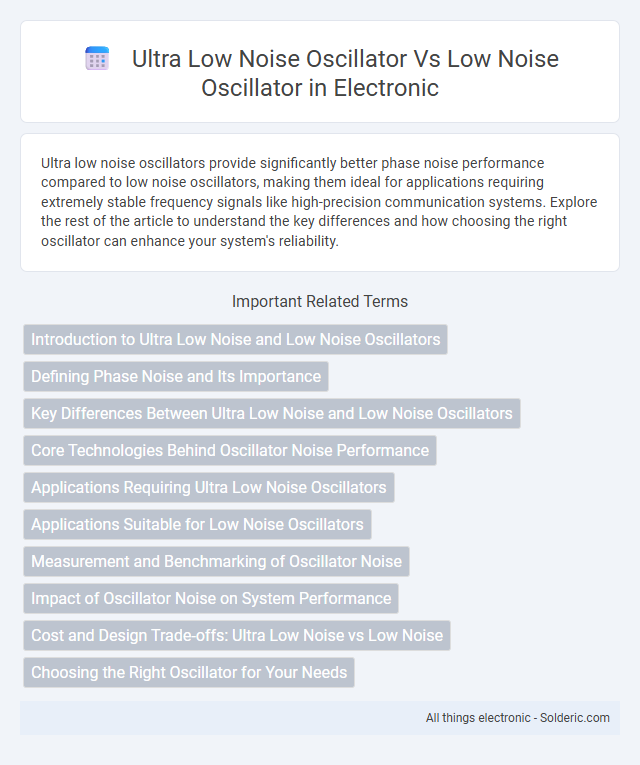Ultra low noise oscillators provide significantly better phase noise performance compared to low noise oscillators, making them ideal for applications requiring extremely stable frequency signals like high-precision communication systems. Explore the rest of the article to understand the key differences and how choosing the right oscillator can enhance your system's reliability.
Comparison Table
| Feature | Ultra Low Noise Oscillator | Low Noise Oscillator |
|---|---|---|
| Phase Noise | -160 dBc/Hz at 10 kHz offset | -140 dBc/Hz at 10 kHz offset |
| Frequency Stability | +-0.1 ppm or better | +-1 ppm typical |
| Output Frequency Range | 1 MHz to 1 GHz | 1 MHz to 1 GHz |
| Power Consumption | Higher due to advanced noise reduction | Lower, suitable for general applications |
| Applications | Precision measurements, atomic clocks, radar systems | Communication systems, consumer electronics |
| Cost | Higher cost due to advanced technology | More affordable |
Introduction to Ultra Low Noise and Low Noise Oscillators
Ultra low noise oscillators exhibit phase noise levels significantly below standard low noise oscillators, enhancing signal stability in high-precision applications like radar and communication systems. Low noise oscillators provide reduced phase noise compared to general oscillators but do not achieve the same minimal noise floor as ultra low noise variants. The distinction between these oscillators lies primarily in their noise performance metrics, measured in dBc/Hz, influencing overall system sensitivity and error rates.
Defining Phase Noise and Its Importance
Phase noise refers to the rapid, short-term fluctuations in the phase of a signal, which can degrade the performance of oscillators by causing signal instability and spectral spreading. Ultra low noise oscillators offer significantly lower phase noise compared to standard low noise oscillators, making them essential for high-precision applications like radar, communications, and frequency synthesis. Your choice between these oscillators impacts the clarity and accuracy of signal transmission, where minimizing phase noise ensures optimal system performance and reduced error rates.
Key Differences Between Ultra Low Noise and Low Noise Oscillators
Ultra Low Noise Oscillators exhibit significantly lower phase noise levels, typically measured in dBc/Hz, compared to standard Low Noise Oscillators, making them ideal for precision applications like high-frequency communication systems and sensitive radar equipment. Their design incorporates advanced noise reduction techniques such as superior crystal technology, temperature stabilization, and refined circuitry, resulting in enhanced signal purity and stability. Selecting an Ultra Low Noise Oscillator over a Low Noise Oscillator can dramatically improve your system's overall spectral performance by minimizing signal jitter and interference.
Core Technologies Behind Oscillator Noise Performance
Ultra low noise oscillators leverage advanced oscillator topologies such as oven-controlled crystal oscillators (OCXOs) and low phase noise voltage-controlled oscillators (VCOs) incorporating high-Q resonators. Noise performance is enhanced by precision temperature control, low flicker noise components, and innovative buffer stages that minimize phase jitter. In contrast, standard low noise oscillators typically use simpler quartz crystal designs and passive stabilization methods, resulting in higher phase noise floors and less thermal drift compensation.
Applications Requiring Ultra Low Noise Oscillators
Ultra low noise oscillators are essential in applications demanding exceptional signal purity, such as high-precision radar systems, deep-space communications, and advanced measurement instrumentation. These oscillators minimize phase noise to a few femto-radians, outperforming standard low noise oscillators used in telecommunications and consumer electronics. The superior noise performance in ultra low noise oscillators ensures enhanced system sensitivity and accuracy in scientific research and military radar detection.
Applications Suitable for Low Noise Oscillators
Low noise oscillators are essential in applications like communication systems, radar, and high-precision instrumentation where phase noise performance directly impacts signal clarity and accuracy. These oscillators support low jitter in clock generation for high-speed digital circuits, enhancing data integrity. Your choice of a low noise oscillator ensures optimal performance in systems requiring stable frequency sources with minimal spectral impurities.
Measurement and Benchmarking of Oscillator Noise
Measurement and benchmarking of ultra low noise oscillators involve precise phase noise analysis and spectral purity assessment under controlled environmental conditions, typically using phase noise analyzers and cross-correlation techniques to minimize instrument noise floor influence. Low noise oscillators exhibit higher phase noise levels, making their benchmarking less stringent but still essential for applications requiring moderate signal stability. Establishing noise floor baselines and using metrics such as Allan deviation enables comparative evaluation, highlighting ultra low noise oscillators' superior noise performance in high-precision timing and frequency reference systems.
Impact of Oscillator Noise on System Performance
Ultra low noise oscillators significantly reduce phase noise and jitter, enhancing signal clarity and stability in high-precision applications such as radar, communication systems, and high-speed data converters. Low noise oscillators, while effective, often cannot achieve the same minimal noise floor, leading to increased error rates, reduced sensitivity, and compromised overall system performance in demanding environments. Optimizing oscillator noise directly improves signal-to-noise ratio (SNR), frequency stability, and timing accuracy, critical for advanced electronic instrumentation and telecommunications.
Cost and Design Trade-offs: Ultra Low Noise vs Low Noise
Ultra low noise oscillators typically incur higher costs due to the use of specialized components, advanced circuit topologies, and stringent manufacturing processes that minimize phase noise beyond standard low noise oscillators. Design trade-offs include increased complexity, larger PCB footprints, and higher power consumption to achieve ultra low noise performance compared to low noise oscillators which offer a balanced compromise between noise performance, cost efficiency, and design simplicity. Selecting between ultra low noise and low noise oscillators depends on application requirements for spectral purity versus budget constraints and device integration flexibility.
Choosing the Right Oscillator for Your Needs
Selecting the right oscillator depends on the noise performance required; ultra low noise oscillators minimize phase noise and jitter to critical levels, ideal for high-precision applications like radar and communication systems. Low noise oscillators provide adequate stability and reduced noise for general-purpose uses such as clock generation in consumer electronics. Assessing system sensitivity to noise and phase stability dictates whether the typically higher cost of ultra low noise oscillators is justified over standard low noise alternatives.
Ultra low noise oscillator vs Low noise oscillator Infographic

 solderic.com
solderic.com